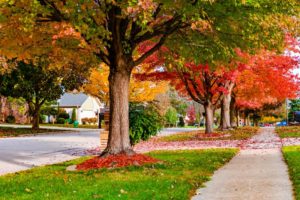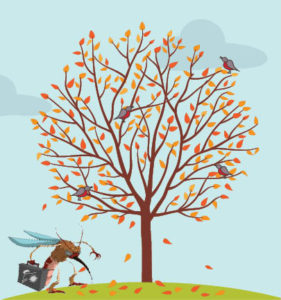
With the crips breeze and lower temperatures gracing the area, many homeowners are starting to think about fall and all that comes with it. While you make plans for fall festivals, bonfires, and Halloween, don’t forget to allot time to your trees. Fall tree care plans are extremely important to help your tree thrive this fall season while preparing it for the cold winter months. To help our clients, we’ve compiled a list of the 5 most important fall tree care tips. Read on to learn what you should do these next few months to keep your tree healthy.
1. Fertilizing
Fertilizing is one of the best ways to keep your trees healthy. Applying in the fall helps protect the tree from winter damage.
Trees in the forest have an abundance of nutrients because of the delicate forest environment that has evolved over millions of years. The trees in our yards; however, are a whole other story. Trees in urban and suburban environments face high-stress conditions like low moisture availability, compaction, physical damage, and construction. Plus as we rake away leaves, twigs, and fall bark we remove nutrients that would have naturally decomposed, feeding the roots.
When faced with these conditions, trees will not reach their full landscape potential, have a shorter lifespan, and will be more susceptible to insects and diseases. To combat this fertilize your trees with Bio-Stimulants, a natural way to give your tree the nutrients it needs without disturbing the soil balance.
2. Mulch

Mulching insulates a tree’s roots helping protect it from the approaching cold of late fall and winter. It also helps the soil retain moisture and organic matter. Applying mulch around trees is one of the best things you can do for the health of your trees. Especially for young trees, mulching is a quick and cost-effective technique that provides numerous benefits.
However, applying mulch incorrectly can cause a lot of issues for your tree. Learn how to apply mulch with our tips below and check out our 5 Common Mulching Mistakes article to know what to avoid!
How To Apply Mulch:
Size: The best mulching goes out as far as the drip line of the tree. However, this isn’t reasonable for most homeowners with large trees. If this isn’t practical, apply mulch in a 2 to 3-foot radius around the tree instead.
Depth: About 2-4 inches
3. Treat For Borers

At this time of year, borers are looking for susceptible trees to enter and spend their winter in. By making your tree unappealing to borers in late summer and early fall, borers will find other trees to enter and feed on which stops the borer infestation before it begins. If you wait until the signs of borers show up in the spring, the damage will already have been done.
Borers are one of the most destructive pests that plague a wide variety of tree species. The most common borers in the DC Metro area include the Asian Longhorned Beetle, Bronze Birch Borer, Emerald Ash Borer, and Ambrosia Beetle.
To combat against these borers, it’s best to invest in preventive borer treatments during this time of year. Our Certified Arborists will be able to recommend the best borer treatment for your tree. Depending on the type of borer most likely to infest your tree, you may need a horticultural oil treatment, bark spray, or injection. Also make sure to keep your tree in good overall health through proper watering, pruning, and fertilizing since borers tend to go for weaker trees.
4. Plant New Trees

If you’re thinking of adding trees or shrubs to your landscape, fall is the time. Most people think it’s best to plant trees in spring because they will get lots of sun and warm weather but this is incorrect. For new trees planted in spring, the heat and drought of summer comes too quickly and they often die from stress and secondary invaders. If you choose to plant your trees and shrubs during the fall (typically September-Mid Oct) they will have a much better chance of surviving for a number of reasons including those listed below.
- Cooler temperatures mean there is less chance of the new tree dying from heat stress.
- Low transpiration (the evaporation of water from a plant’s leaves) levels during the fall lower the risk of drought stress for the tree/shrub.
- Without the pressure of sprouting new canopy growth, the tree/shrub focuses its energy on developing new root growth. Resulting in a stronger, more developed root system.
- Fall moisture also encourages new root growth.
- Fewer diseases and insects are active than in the spring or summer, lowering the risk of infection/infestation.
5. Rake Routinely

We mentioned above that raking leaves removes nutrients that would have naturally decomposed into the soil, which is true. However, for health purposes, it’s best to remove these leaves to prevent disease, fungi, and insect issues in the spring. Disease-causing fungi and insect eggs love to hide and overwinter in a tree’s fallen leaves. This makes leaving leaves to decompose a risk factor for your tree contracting diseases in the Spring.
When the weather starts to warm in spring raindrops awaken the overwintering spores allowing them to reinfect the tree. And when the weather becomes warm enough, the overwintering insect eggs hatch infesting the tree. Raking these leaves & removing them will limit your tree’s chances of contracting a disease or being re-infected.
Now that you know the 5 most important fall tree care tips, get to work this weekend caring for your trees. Or better yet, just hire our experts to do it for you! Schedule a consultation with one of our Certified Arborists to discuss your fall tree care needs to get started. Schedule an appointment online or give us a call at 703-573-3029.


